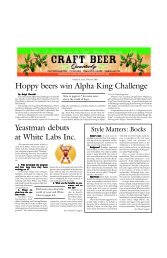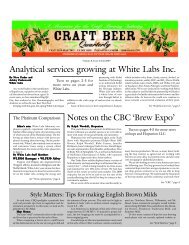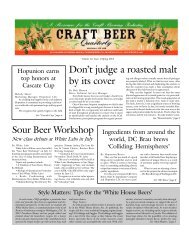You also want an ePaper? Increase the reach of your titles
YUMPU automatically turns print PDFs into web optimized ePapers that Google loves.
Craft B eer Quarterly<br />
Style Matters<br />
staight-forward, as you will want to use your favorite<br />
Belgian yeast, although ideally one that will accentuate<br />
the hops in your beer given the American influence in<br />
this style. Diacetyl and sulfur character must be avoided.<br />
Some suggested yeast strains include: WLP500<br />
Trappist Ale Yeast, WLP530 Abbey Ale Yeast (similar to<br />
WLP500, but less fruity and more alcohol tolerant),<br />
WLP540 Abbey IV Ale Yeast (fruit character is medium,<br />
in between WLP500 and WLP530). and WLP545 Belgian<br />
Strong Ale Yeast (produces moderate levels of ester<br />
and spicy phenolic character).<br />
— White Labs<br />
Malt Notes:<br />
Being the malt-heads we are, everyone at Briess is<br />
intrigued with the Dark American-Belgo-Style Ale style<br />
because its description reads like a poster child for specialty<br />
malts. GABF style guidelines define the general flavors<br />
and characteristics of this style, which is a subcategory<br />
of American-Belgo-Style Ale, but don’t inhibit<br />
the malt-empowered brewer with a predefined list of malt<br />
flavors or styles. In fact, guidelines clearly assign creative<br />
license to brewers: “These beers must portray the unique<br />
characters imparted by yeasts typically used in fruity and<br />
big Belgian-style ales. These beers are not traditional Belgian<br />
styles which are already defined. They are unique<br />
beers unto themselves.”<br />
Colors start at 16SRM and should fall in the deep<br />
amber/brown to black range. And, GABF guidelines<br />
continued, “Roasted malts or barley may have a range of<br />
character from subtle to robust, and should be reflected<br />
in the overall character and balance of the beer.”<br />
Page 6<br />
Hop Pages<br />
So, after completing the creative process and determining<br />
the target flavor of your DABSA, it’s time to<br />
formulate. Select your malts with care, keeping in mind<br />
these specialties that may deliver the flavors you want in<br />
your DABSA:<br />
· Pale Ale Malt. This is a rich, full-flavored beer. It<br />
needs a rich malty backbone. We recommend Briess Pale<br />
Ale to deliver that plus nice subtle hints of biscuit and<br />
nuts. It’s a fully modified, high extract, low protein 2-<br />
Row Malt.<br />
· Bonlander® Malt, or another Briess Munichstyle<br />
malt. If your DABSA will lean toward robust roasted<br />
malt flavor, we recommend this additional dose of malty<br />
flavor to hold up to the roasted malt and other flavors<br />
that may be involved, such as spices or berries.<br />
· Caracrystal® Wheat Malt. Mixed in the wide<br />
range of Briess roasted caramel malts is this seasonal malt<br />
available Jan-Jun every year. It has a color of 55 ºL and<br />
contributes orange to mahogany hues. This is a rather<br />
complex caramel malt, with malty, caramel, dark toast<br />
flavors that would make an interesting addition to this<br />
beer style.<br />
Sponsored by <strong>Hopunion</strong><br />
Falconer’s Flight ® initiative makes inroads<br />
Helps expand scholarship opportunities<br />
Melody Meyer<br />
Marketing Manager, <strong>Hopunion</strong> LLC<br />
Since 2010, <strong>Hopunion</strong> LLC has been<br />
proud to support the Glen Hay Falconer<br />
Foundation’s brewing education scholarships<br />
program through proceeds from the<br />
Falconer’s Flight® pellet blend. To date,<br />
$100,000 has been donated to the foundation<br />
in support of Glen’s vision to increase<br />
educational opportunities for current<br />
and aspiring craft brewers.<br />
This winter, a portion of the Falconer’s<br />
Flight initiative will be realized as the Glen<br />
Hay Falconer Foundation, in collaboration<br />
with the Siebel Institute of Technology,<br />
proudly expands their scholarship<br />
offerings to include two full-tuition brewing<br />
education scholarships.<br />
Similar to the past, the Foundation<br />
will present one scholarship to the World<br />
Brewing Academy Concise Course in<br />
Brewing Technology, a two-week intensive<br />
program that covers every topic criti-<br />
cal to successful brewery operations. This<br />
year, the scholarship will be offered at the<br />
Chicago campus during October/November<br />
2013.<br />
The program is designed for brewers<br />
pursuing a wider knowledge of professional<br />
brewing standards and techniques<br />
in order to advance their brewing careers<br />
as well as individuals planning to enter the<br />
brewing industry and includes a $1,000<br />
stipend to help offset travel and lodging<br />
expenses.<br />
New for 2013, the Foundation will<br />
proudly present one full tuition World<br />
Brewing Academy International Diploma<br />
Course scholarship. The International<br />
Diploma course is a 12-week comprehensive<br />
course intended for brewers seeking<br />
an in-depth understanding of the technical<br />
aspects and practical application of<br />
brewing science and technology, running<br />
from September to November 2013 at<br />
Siebel’s Chicago and Munich campuses.<br />
The scholarship includes a stipend<br />
of up to $5,000 to help offset<br />
travel and lodging expenses.<br />
In addition to expanding<br />
their scholarship programs, the<br />
Falconer Foundation will be expanding<br />
their geographical reach<br />
as well, accepting applicants from<br />
Washington, Oregon, Idaho,<br />
Montana, Wyoming, Colorado,<br />
Utah, Nevada, California, Alaska,<br />
and Hawaii.<br />
Through the Falconer’s<br />
Flight® initiative, <strong>Hopunion</strong> is<br />
proud to support the Glen Hay<br />
Falconer Foundation scholarship<br />
program and help raise awareness of its<br />
mission to contribute to the Northwest<br />
craft brewing community by providing<br />
opportunities for professional and aspiring<br />
brewers to further their knowledge and<br />
expertise.<br />
The Glen Hay Falconer Foundation<br />
is a nonprofit organization created to commemorate<br />
and celebrate the life, interests,<br />
and good works of a well-loved and lead-<br />
2012 Sasquatch Brewfest / Falconer’s Flight®<br />
donation presentation<br />
ing Northwest brewer, Glen Hay Falconer.<br />
To learn more about the foundation<br />
or any of its scholarship opportunities,<br />
visit www.glenfalconerfoundation.org.<br />
Applicants can also visit http://<br />
www.siebelinstitute.com to learn more.<br />
Candidates can only apply for one of<br />
the two scholarships and must live in the<br />
stated geographic region on March 25,<br />
2013 to be eligible for the scholarship.<br />
From Page 1<br />
The Dark Amierican-Belgo-Style Ale style should showcase and celebrate<br />
hops: ‘Hop aroma, flavor and bitterness not usually found in the<br />
base style, can be medium to very high and must show the characters of<br />
American hop varieties’<br />
· Special Roast Malt. At 45 ºL this roasted malt<br />
adds unique toasty, biscuity, sourdough, tangy flavors<br />
for complexity.<br />
· Extra Special Malt. This is a hybrid 2-Row drumroasted<br />
malt with both caramel and dry roasted flavors.<br />
It’s distinguished by some interesting prune/dry/woody<br />
flavors. 130 ºL.<br />
· Dark Chocolate Malt. 420 ºL, super smooth,<br />
rich roasted coffee flavor.<br />
· Roasted Barley. For rich, sharp flavor plus foam<br />
color. 300º L. Brewers who use this roasted barley ingredient<br />
really like it, reporting that it has a unique flavor<br />
among its peers in the Roasted Barley category.<br />
· Blackprinz® or Midnight Wheat Bitterless<br />
Black Malt. How dark do you want your DABSA? At<br />
500 and 550 ºL respectively, these bitterless black malts<br />
add dark color but no bitter flavor or aftertaste. They<br />
serve as room darkening shades, blocking the light but<br />
not the subtle rich, complex flavors expected from a much<br />
lighter-colored Belgian yeast-fermented beer.<br />
— Briess Malt & Ingredients Co.






